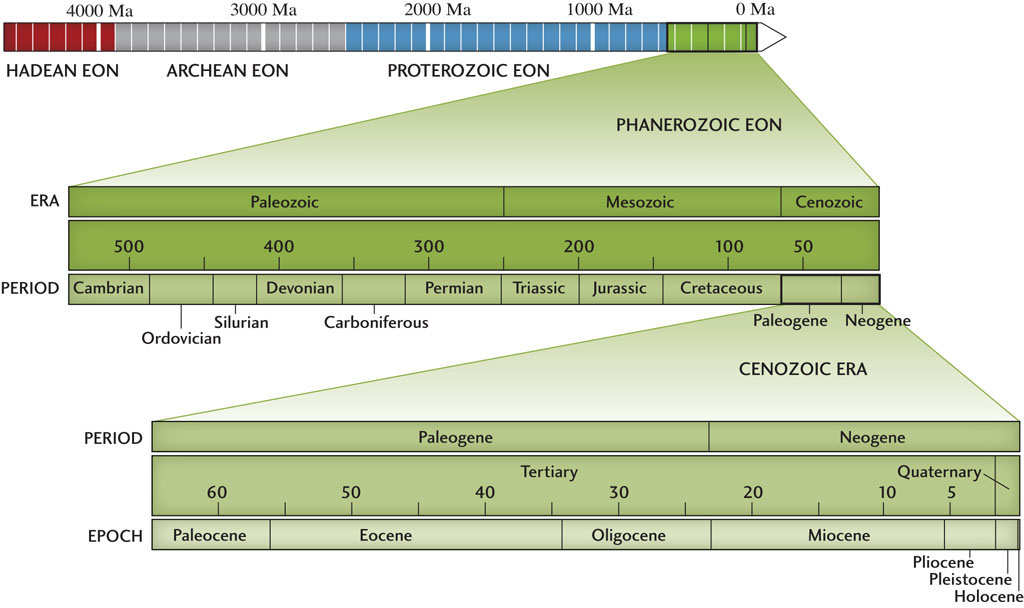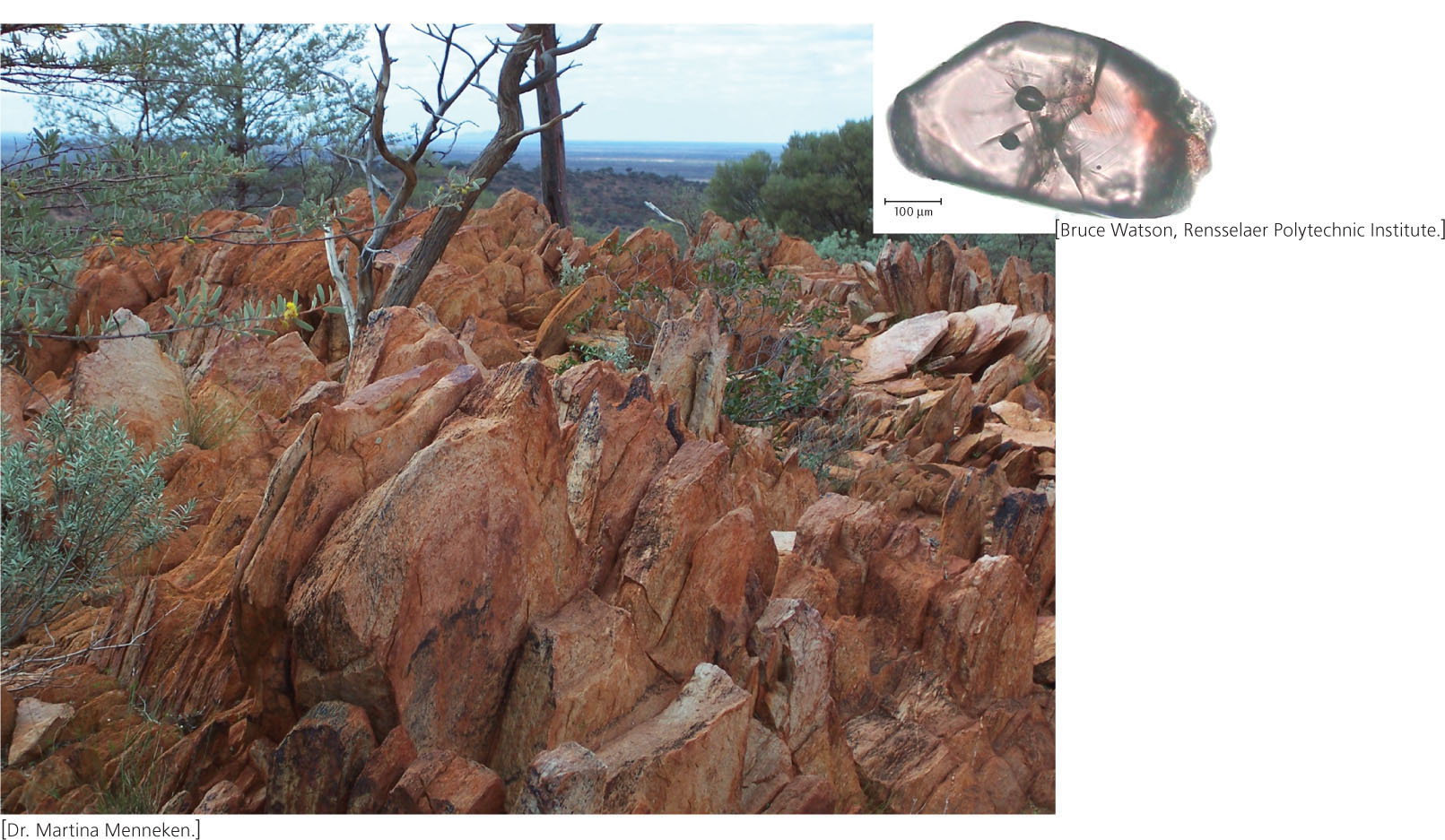The Geologic Time Scale: Absolute Ages
Armed with isotopic dating techniques, geologists of the twentieth century were able to nail down the absolute ages of the key events on which their predecessors had based the geologic time scale. More important, they were able to explore the early history of the planet recorded in Precambrian rocks. Figure 8.15 presents the results of this century-long effort.

The assignment of absolute ages to the geologic time scale revealed great differences in the lengths of the geologic periods. The Cretaceous period (spanning 80 million years) turned out to be more than three times longer than the Neogene period (only 23 million years), and the Paleozoic era (291 million years) was found to be longer than the Mesozoic and Cenozoic eras combined. The biggest surprise was the Precambrian, which had a duration of over 4000 million years—almost nine-tenths of Earth’s history!
Eons: The Longest Intervals of Geologic Time
To represent the rich history of the Precambrian, a division of the geologic time scale longer than the era, called the eon, was introduced. Four eons, based on the isotopic ages of terrestrial rocks and meteorites, are now recognized.
Hadean Eon
The earliest eon, whose name comes from Hades (the Greek word for “hell”), began with the formation of Earth 4.56 billion years ago and ended about 3.9 billion years ago. During its first 650 million years, Earth was bombarded by chunks of material from the early solar system. Although very few rock formations survived this violent period, individual zircon grains with ages as great as 4.4 billion years have been found, indicating that Earth had a felsic crust within 200 million years of its formation. There is also evidence that some liquid water existed on Earth’s surface at about this time, suggesting that the planet cooled rapidly. In Chapter 9, we will explore this early phase of Earth’s history in more detail.
Archean Eon
The name of the next eon comes from archaios (the Greek word for “ancient”). Rocks of Archean age range from 3.9 billion to 2.5 billion years old. The geodynamo and the climate systems were established during the Archean eon, and felsic crust accumulated to form the first stable continental masses, as we will see in Chapter 10. The processes of plate tectonics were probably operating by the end of the Archean, although perhaps substantially differently from the way they did later in Earth’s history. Life, in the form of primitive single-celled microorganisms, became established, as indicated by the fossils found in sedimentary rocks of this age.
Proterozoic Eon
The last part of the Precambrian is the Proterozoic eon (from the Greek words proteros and zoi, meaning “earlier life”), which spans the time interval from 2.5 billion to 542 million years ago. By the beginning of this eon, the plate tectonic and climate systems were working much as they do today. Throughout the Proterozoic, organisms that produced oxygen as a waste product (as plants do today) increased the amount of oxygen in Earth’s atmosphere. We will explore the early evolution of life and its effects on the Earth system in Chapter 11.
211
Phanerozoic Eon
The start of the Phanerozoic eon is marked by the first appearance of shelly fossils at the beginning of the Cambrian period, now dated at 542 million years ago. The name of this eon—from the Greek phaneros and zoi (“visible life”)—certainly fits, because it comprises all three eras originally recognized in the fossil record: the Paleozoic (542 million to 251 million years ago), the Mesozoic (251 million to 65 million years ago), and the Cenozoic (65 million years ago to the present).
Perspectives on Geologic Time
In the dusty sheep country of far western Australia stands a small promontory of ancient red rocks called the Jack Hills (Figure 8.16). Geologists have pulverized truckloads of these rocks to isolate a few sand-sized crystals of zircon. By measuring the lead-206 and lead-207 isotopes generated by the radioactive decay of uranium-238 and uranium-235, as described above, they have identified one small crystal fragment with an age of 4.4 billion years—the oldest mineral grain yet discovered in Earth’s crust. How can we relate to such a mind-boggling span of time?

Imagine compressing the 4.56 billion years of Earth history into a single year, starting with the formation of Earth on January 1 and ending at midnight on December 31. Within the first week, Earth was organized into core, mantle, and crust. The oldest zircon grain from the Jack Hills crystallized on January 13. The first primitive organisms appeared in mid-March. By mid-June, stable continents had developed, and throughout the summer and early fall, the biological activity of evolving life increased the concentration of oxygen in the atmosphere. On November 18, at the beginning of the Cambrian period, complex organisms, including those with shells, appeared. On December 11, reptiles evolved, and late on Christmas Day, the dinosaurs became extinct. Modern humans, Homo sapiens, did not appear on the scene until 11:42 p.m. on New Year’s Eve, and the most recent ice age did not end until 11:58 p.m. Three and a half seconds before midnight, Columbus landed on a West Indian island, and a couple of tenths of a second ago, you were born!
212